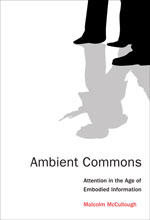 A review of
A review of
Ambient Commons: Attention in an Age of Embodied Information
By Malcolm McCullough
MIT Press, 2013
Malcolm McCullough, a professor of architecture at the University of Michigan, was a well-received invited speaker at UPA 2004. Our evaluations of his session were strongly positive, and many of us still fondly remember his witty combination of intellectual scholarship and truths about contemporary society. In Ambient Commons, his third book from MIT Press, he continues his observations on cognition and architecture at the elementary level where architecture and communication intersect. Many of his comments are addressed specifically to those of us who play roles in information design and interactions with “the built environment.”
According to McCullough, many people walk around with their eyes and brains locked in the embrace of “glowing rectangles” (LED displays and touch screens) ignoring “the ambient delights of the unmediated world.” For him, the ambient is everything in our immediate surroundings, including—among things we notice or don’t notice—the pervasive music on our headphones, speaker systems, and in elevators, but also the breeze rustling leaves in the trees. It’s all about paying attention…or not.
The commons—as in civic open space, a park, or community gardens—is traditionally a physical space that is not owned by anyone but is shared by everyone. Exploring the commons, McCullough indulges in “psychogeography,” a practice defined fifty years ago by “situationists” who deplored humanity’s slide into monoculture and advocated walking among, and noticing, “less-noticed things.” Please notice that McCullough is a speaker and writer who makes fluent use of new vocabulary, as in “crowd-sourcing the infrastructure” or “a DIY commons”—not an oxymoron here but a variation on “inescapably shared information [which] becomes a new kind of commons.”
Word games? Absolutely, but with serious respect for the inconvenient truths some of his unconventional language reveals. McCullough refers to “planetary change,” rather than either “global warming” or “climate change,” thereby avoiding offense to either the American left or right. From early in the text through his conclusions, he insists that what he’s put together is not a thesis but an “inquiry,” one that invites our participation.
The structure of this inquiry leads us through a seductive progression from the obvious (a view of sunlight crossing a wall) to the sophisticated (“governing the ambient, as if it were a commons.”) Chapter 4, a definition of “embodiment,” is a pivot that moves readers from the inescapable observation of our surroundings to a “cognitive science of engagement,” whether initiated by the individual or the circumstances surrounding the individual.
A sample of McCullough’s text and thinking:
“In architecture and urbanism, you can’t just turn off the screen or flip to another channel. You have to live in the artifacts. Despite how private and public players have shaped particular elements of built space, there is always some common circumstance to inhabitation, a circumstance that shapes action and perception. Now, as information technologies infuse these circumstances, how does that affect inhabitation?”
Chapter 6, “Tagging the Commons,” inventories all kinds of “tags”—spray paint, stickers and stencils, posters and handbills, carved inscriptions, banking and other corporate logos, rampant signage, RFID chips, and more. “Advertising makes brands into places and places into brands,” says McCullough (like the San Francisco Giants’ home at “AT&T Park” down the street from where I’m working). The danger that lurks in such an exhaustive survey of what’s happening around us is that some of the facts can begin to sound dated, including community governments’ not-so-recent efforts to deal with ubiquitous signage and spray paint.
As an architect, McCullough naturally uses schematic drawings as part of his vocabulary, such as the frequent use of squares divided into quadrants to compare, for example, sent versus intrinsic information in specialized versus generalized contexts. As a professor, he also offers summaries of the key takeaways at the end of each chapter, the Main Idea, Counterargument, Key Terms, What Has Changed, Catalyst, Related Field, and Open Debate.
One key to this inquiry is paying attention to “the built environment,” where the high resolution and low demands of architecture provide a base for sense-making. Buildings loaded with signage or GPS interactions with our portable electronics offer opportunities for both the exercise and the occasional rest of our attention; they can be a refuge from “peak distraction” and “data smog.” The implications for information design and human interaction are huge.
The book is both a delight to read and a call to action in two ways. Civilized human beings need to disengage from their glowing rectangles and appreciate the world around us, and design professionals need to pay attention to the information content of our environment.McCullough 的书所探讨的要点之一是关注“人工建筑环境”,这里建筑的高解析度和低要求成为意义建构的基础。即使是挂满指示牌的建筑物,也可以作为远离“峰值干扰”和“数据烟尘”的避难所,对信息设计和人机交互有着很大的影响。 文章全文为英文版 McCullough 의 질문에서 한 가지 핵심은 컴퓨터 시스템 구축 부담이 적고 고해상도가 의미 형성 기반을 제공하는 “인공적 환경”에 주의를 기울이는 것입니다. 신호체계가 갖추어진 건물들은 “강렬한 집중력 분산 요인”과 “데이터 스모그”로부터 피신처가 될 수 있고 정보 디자인과 인간 상호작용에 대한 영향이 엄청납니다. 전체기사는영어로만제공됩니다.
Um aspecto fundamental na pequisa de McCullough é prestar atenção ao “ambiente construído”, no qual a alta resolução e baixa demanda de arquitetura fornecem a base para a abordagem sense-making. Edifícios repletos de sinalização podem ser um refúgio de “ponto máximo de distração” e “excesso de informações” e as implicações para o design de informações e a interação humana são imensas. O artigo completo está disponível somente em inglês.
マックラ氏の問いかけの一つの鍵となるのは、高解像度かつ低需要の建築物が理解の基点となる、「すでにある環境」を注視するということである。適切な標識が設置された建物は、「イライラのピーク」や「情報の洪水」からの逃避所となり得るうえ、情報デザインやヒューマン・インタラクションに対する多大な示唆を与えてくれるのである。 原文は英語だけになります
Una clave en la investigación de McCullough es prestar atención al “entorno construido”, donde la alta resolución y las bajas demandas de la arquitectura ofrecen una base para dar sentido a las cosas. Edificios cargados de letreros pueden ser un refugio contra las distracciones extremas y la sobrecarga de información, y las consecuencias para el diseño de la información y la interacción humana son enormes. La versión completa de este artículo está sólo disponible en inglés
